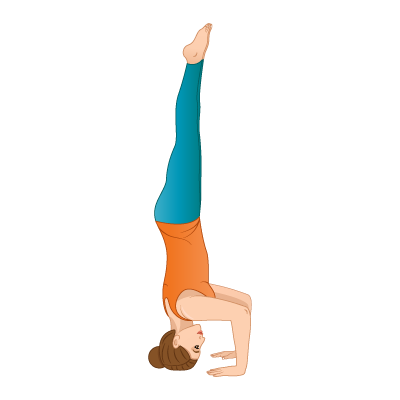Tripod Headstand
Sirshasana II

STEPS
Tripod Headstand is a triple play pose, combining an inversion, balance and arm balance all in one. That makes it a tricky pose for some, but Tripod Handstand is worth the effort as it is a building block pose to advanced inversions and Ashtanga 3rd Series. To prepare for Tripod Headstand begin with shoulder strengthening poses such as chataranga, plank and dolphin. Once you have mastered these poses, you are ready to try Tripod headstand.
Begin from hands and knees pose, with both hands, shoulder width apart. Bend the elbows 90°, elbow over wrist and upper arms are parallel to the ground. Place the crown of the head onto the mat, making a triangle with the head and hands. Curl the toes, lift the knees to straighten the legs and raise the hips as for dolphin. Slowly walk the feet towards the head. . When the hips are over the shoulders, slowly raise one foot vertical and then the other. Ground the palms, lift up through the shoulders and core, straighten the spine and stretch up through the inner heels of the feet with toes touching. To exit the pose, lower one foot and then the other to the ground. Bend the knees and return to start position or child pose.
TEACHER QUEUES
VISUALIZATION COMMENTS
To achieve the full expression of tripod headstand, with the body fully erect and inverted, imagine your legs are being sucked up through a straw.
TECHNICAL COMMENTS
To protect the neck and achieve stability in this pose, it is important to balance on the head crown. To find the head crown, place a block on the head, the balancing point is the crown. The head should be placed just in front, but midway between the hands. With palms flat, push the ground away from you and squeeze the elbows together to engage the shoulders. Lift upwards from the shoulders, core and inner heels. The toes should be touching, inner thighs turning inward, the crown, shoulders, hips and toes are in one line.
BENEFIT COMMENTS
- Strengthens arms and shoulders
- Builds core strength
- Stretches and stretches leg muscles
- Improves balance
- Relieves mild anxiety and depression
- Improves blood flow to brain enhancing mental acuity
- Stimulates pineal and pituitary glands
WATCH OUT FOR
- Alignment (make sure head crown is on floor and head and hands for a triangle)
- Flailing legs ( lift, do not kicking up)
- Neck pain (return to start position)
CONTRAINDICATIONS
- Neck injuries
- Headache and migraine
- High blood pressure
- Heart disease
- Thrombosis
- Arteriosclerosis
- Pregnancy
MODIFICATIONS
- Dolphin (keep toes on floor)
- Place blocks, chairs or headstand stool under shoulders
- Place knees on upper arms
VARIATIONS
- Headstand with head crown placed on floor between hands (sirasana I)
- Unsupported headstand (straighten arms and place hands flat on floor shoulder width apart in in front of head
- Headstand lotus (place legs in lotus)
YOGA COUNTER POSES
- Seated forward bend (Paschimothnasana)
- Child pose (Balasana)
- Savasana
Written By: Brenda Hamlet
Brenda Hamlet is a RYT 200 yoga teacher and journalist. More information about Brenda can be found at https://www.facebook.com/brendahamletyoga



